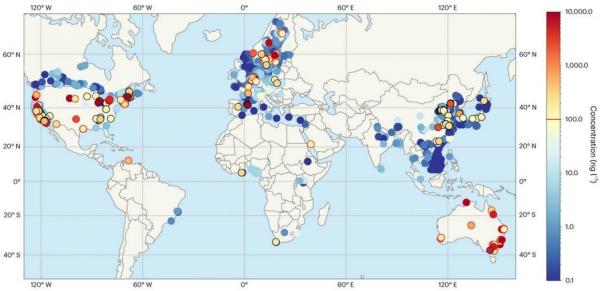Global Study of PFAS concentrations in water show pervasiveness of contamination
Image: Nature Geoscience
18 Apr 2024 by The Water Diplomat

A study published in Nature Geoscience on the 8th of April has combined data from around the world on the concentrations of per- and polyfluoroalkyl substances (PFAS) in surface and groundwater to help improve mitigation measures, such as providing regulatory guidance. PFAS substances are a class of more than 14,000 synthetic chemicals which have been used for more than 70 years in a broad range of industries and consumer products. Their popularity stems from the fact that they are water and oil repellent as well as being resistant to heat. Because of this, PFAS chemicals are used in the production of products such as lubricants, food packaging materials, extinguishing foam, non-stick coatings on pans, clothing, textiles and cosmetics.
However, despite their obvious utility, PFAS substances have raised concern because of their persistence in the environment (leading to them being popularly dubbed as ‘forever chemicals’). They therefore accumulate both in the environment and in the human body and, although the science of PFAS is still emerging and there are thousands of different chemical compounds to be considered, most of them are considered to be moderately to highly toxic and in humans they are currently associated with thyroid disease, increased cholesterol levels, liver damage and kidney and testicular cancer.
Regulators across the world have therefore proposed maximum concentrations of PFAS chemicals in drinking water. Interestingly, as more becomes known about PFAS substances, the European Food Safety Authority has gradually adjusted its estimates of safe levels of PFAS in the human body downward since 2008. According to the EU’s drinking water directive , the sum of the concentration of all PFAS chemicals in drinking water should not exceed 0,5 µg/litre. In the article, the researchers mention that one of the most restrictive recommendations for PFAS levels is that by Health Canada which recommends the sum of all PFAS levels to be lower than 30 nanogrammes per litre.
To generate a global overview of PFAS contamination, the researchers consulted a total of 273 environmental studies that had been conducted since 2004. Together, these studies included data for over 12,000 surface water and 33,900 groundwater samples from around the world. On the basis of the results from these samples, it was possible to assess to what extent the pollution exceeds existing regulatory norms. Of course, since the regulatory norms differ from one country to the next, the fact that PFAS levels exceed the norms has a different implication depending on the country in question.
The researchers found that PFAS are prevalent in both surface- and groundwater around the world. A map generated from the sources suggest that Australia, China, Europe and North America are hotspots for PFAS contamination, although the researchers point out that these areas are also areas where there is a high level of water sampling, so these areas may be somewhat overrepresented simply because of a relative lack of data in other areas.
Furthermore, areas which have high levels of PFAS contamination are either located close to industrial production areas and landfills, or to areas where firefighting foam (‘aqueous film forming foam, (AFFF)’ is produced or used. In areas where there were known sources of either category of PFAS, in the majority of cases the samples exceeded the regulatory norms, independently of which regulatory framework was applied. In areas where there were no known PFAS sources, there were nevertheless high incidences – in the range from 15% to 50% - of samples that exceeded the regulatory norms.
The researchers also attempted to classify and compare different kinds of PFAS substances used in 943 different consumer products. Across the wide variety of chemical substances within this class, this proved to be challenging, also because the studies on which the researchers depended did not always go into his level of detail. Nevertheless, they were able to show that two subclasses of PFAS, i.e. fluorotelomers and perfluoroalkyl carboxylic acids were the most used in consumer products.
